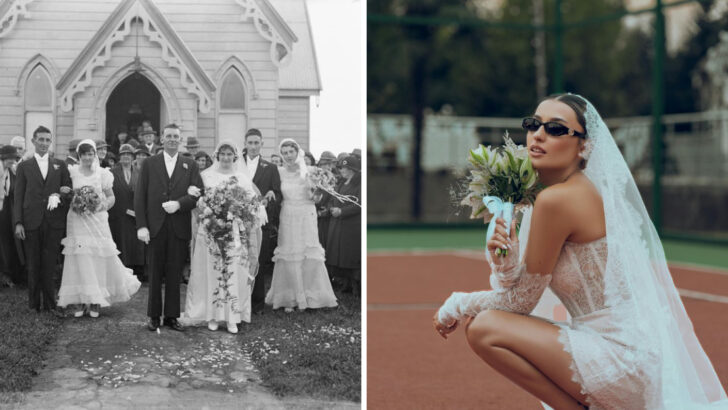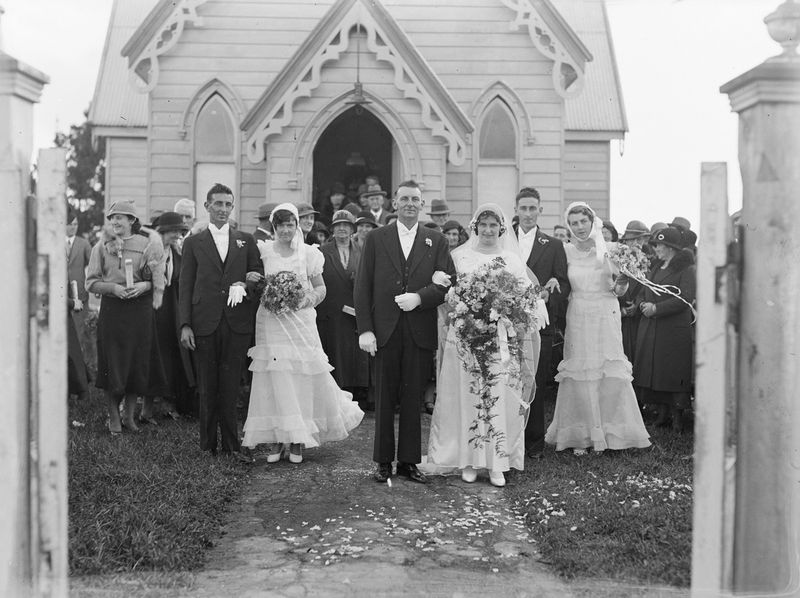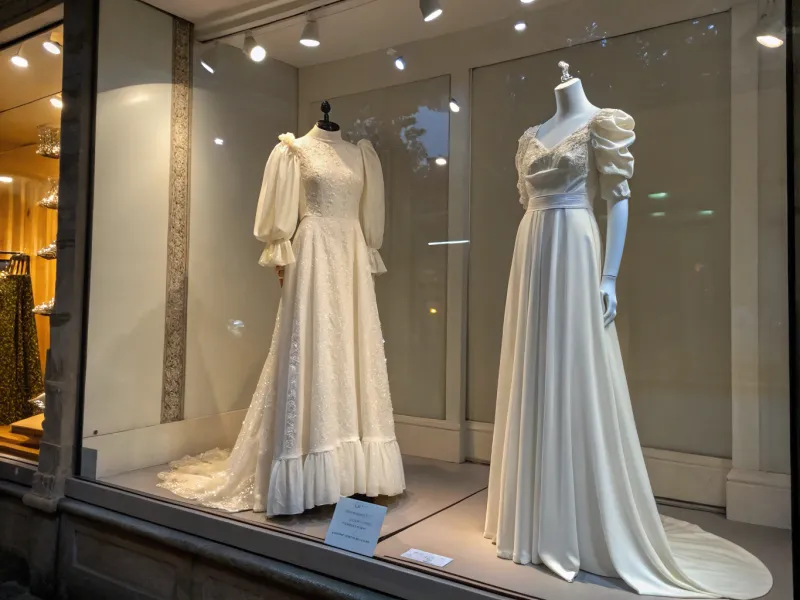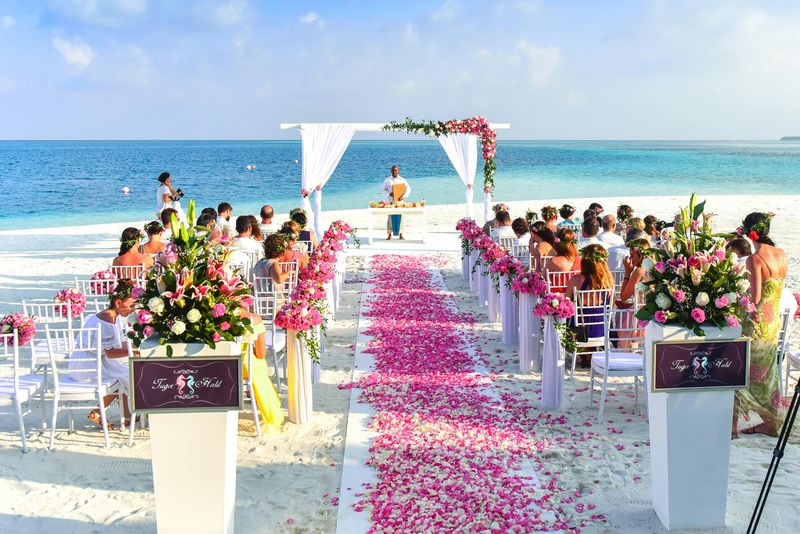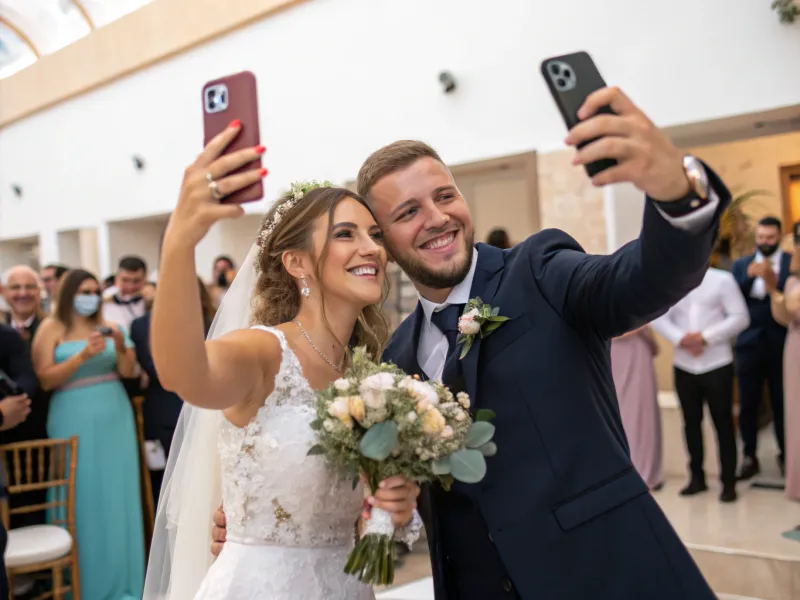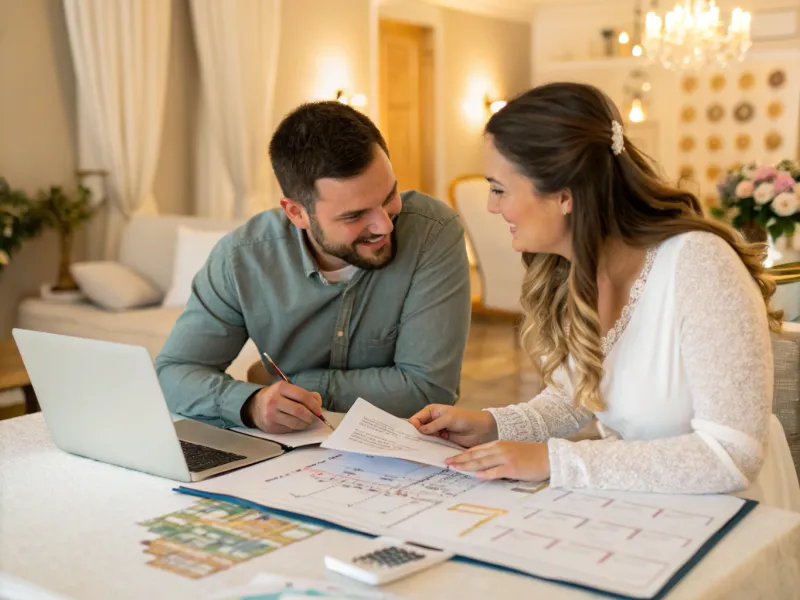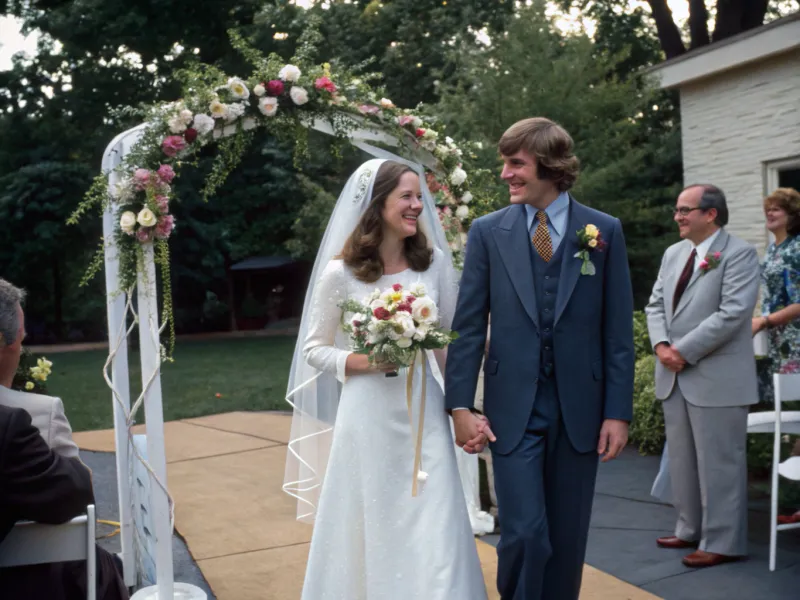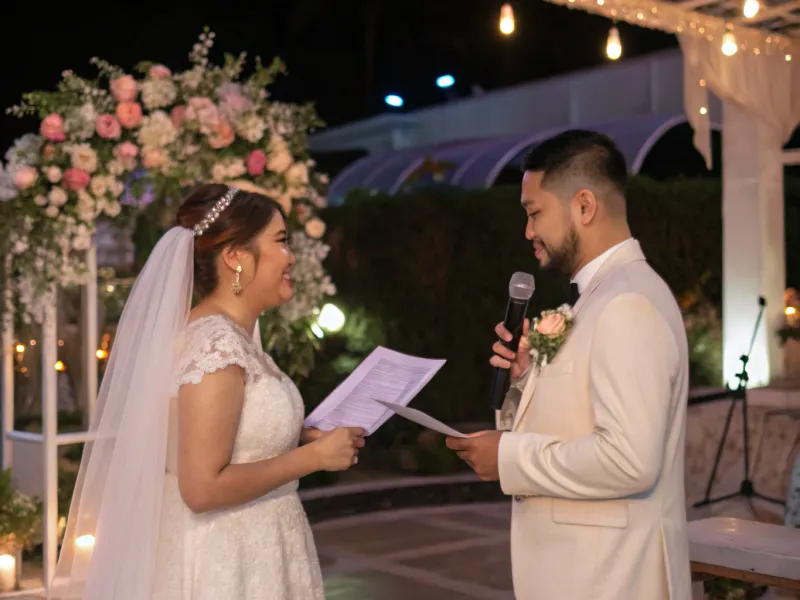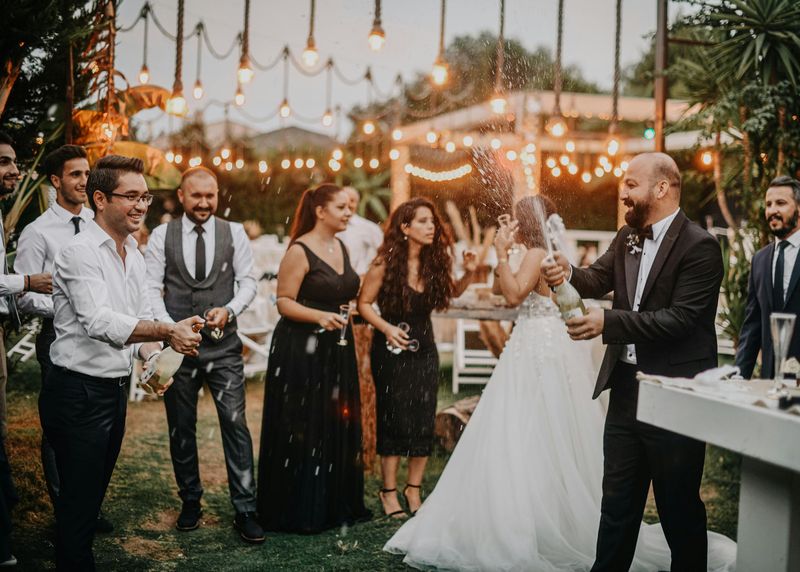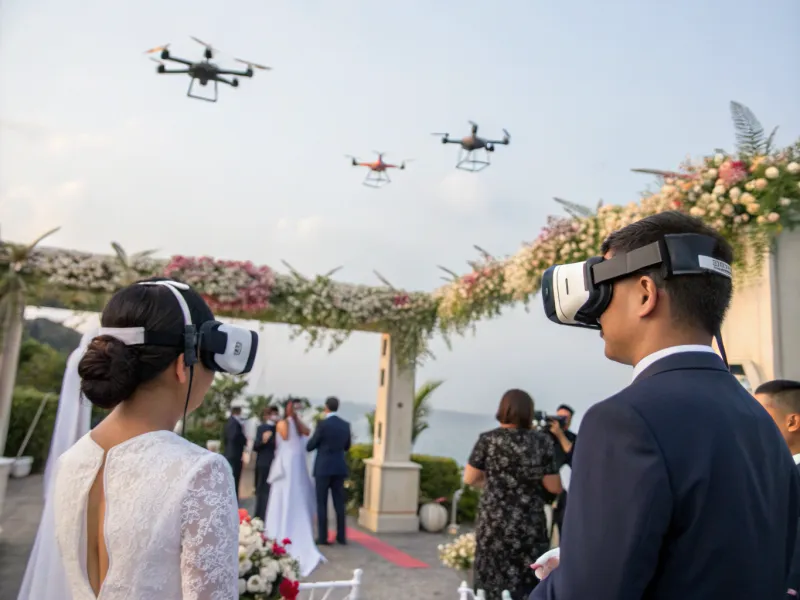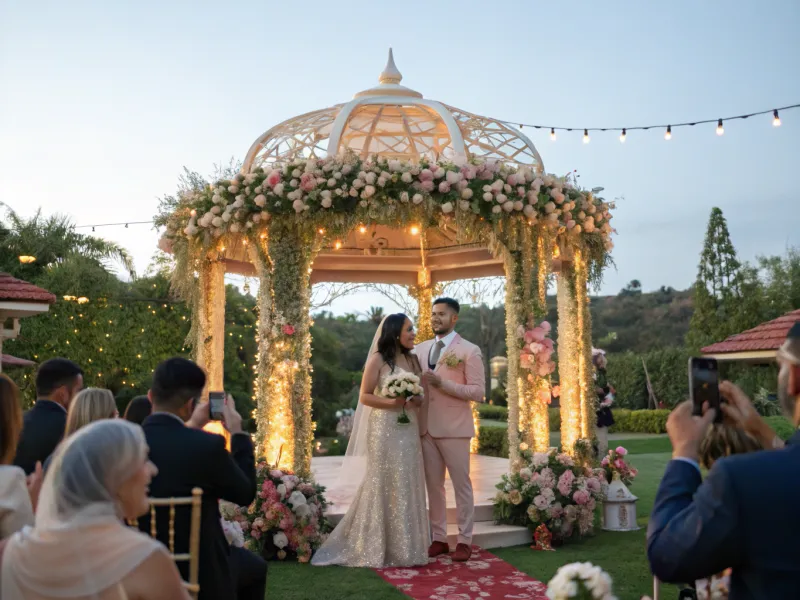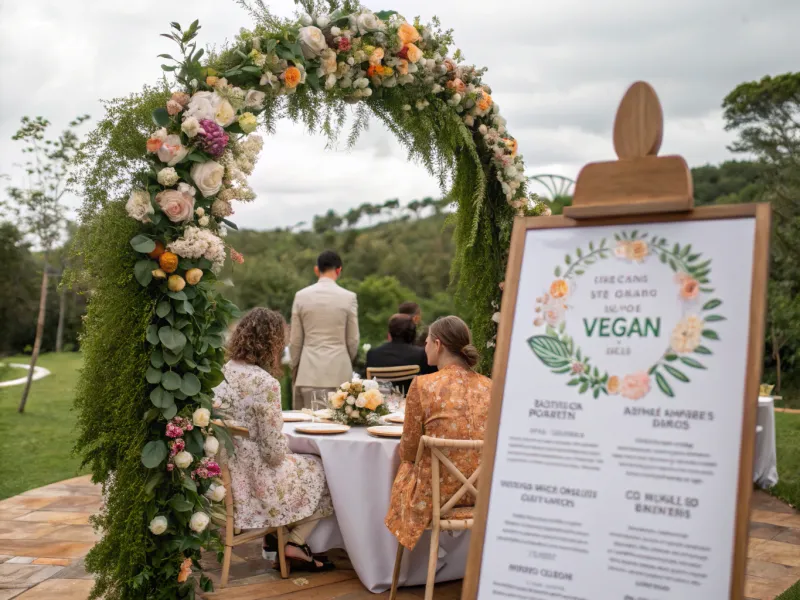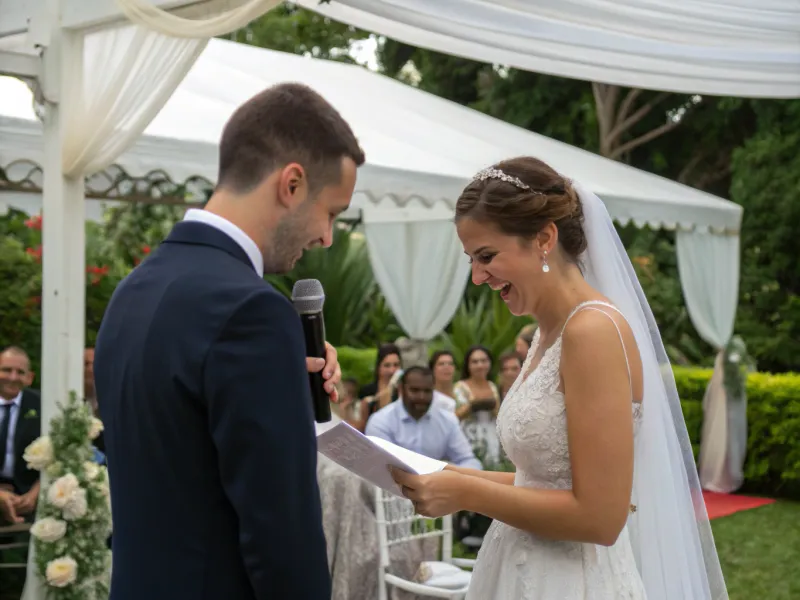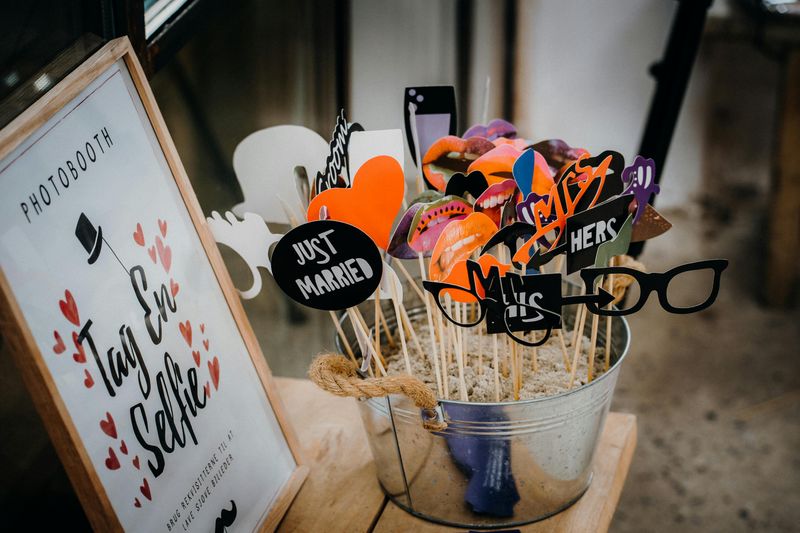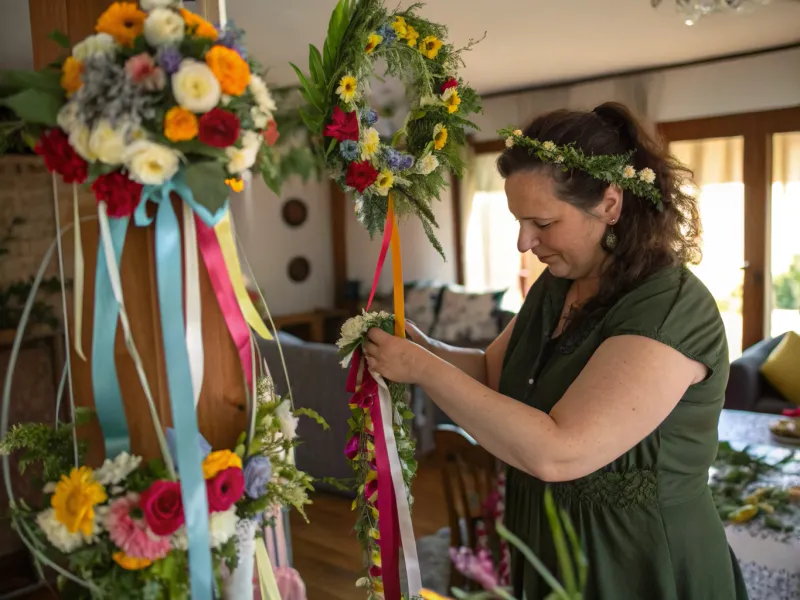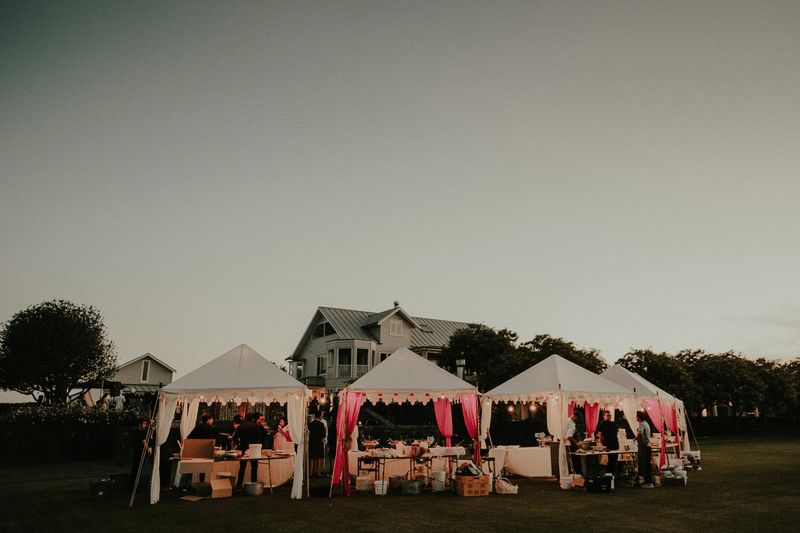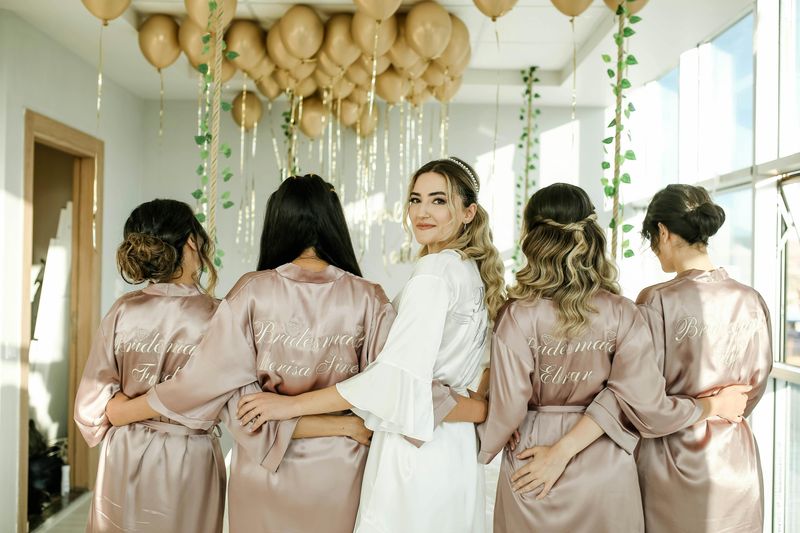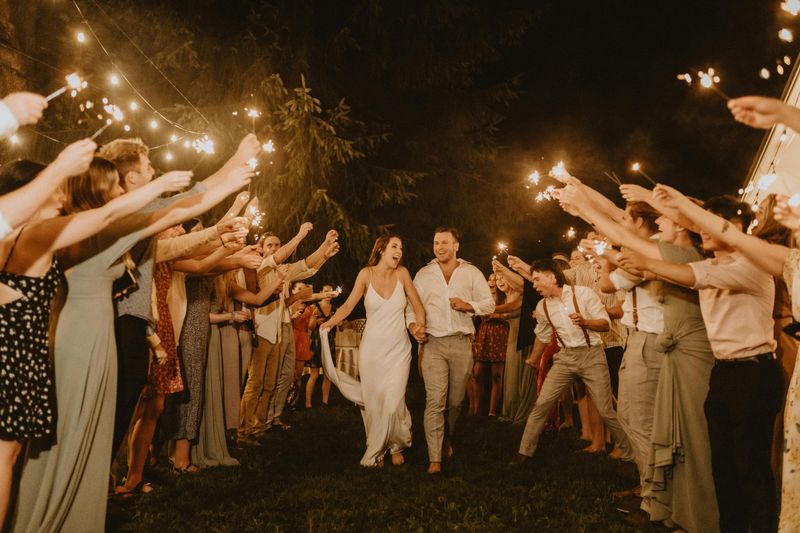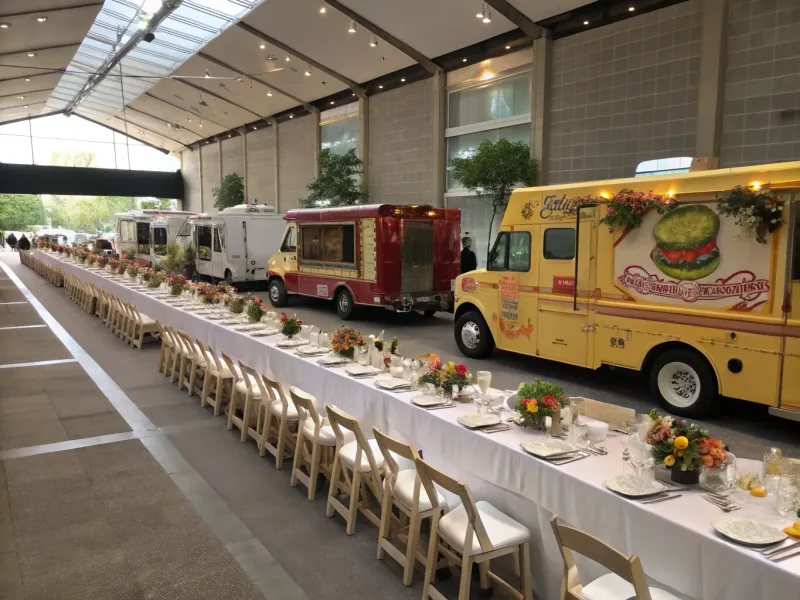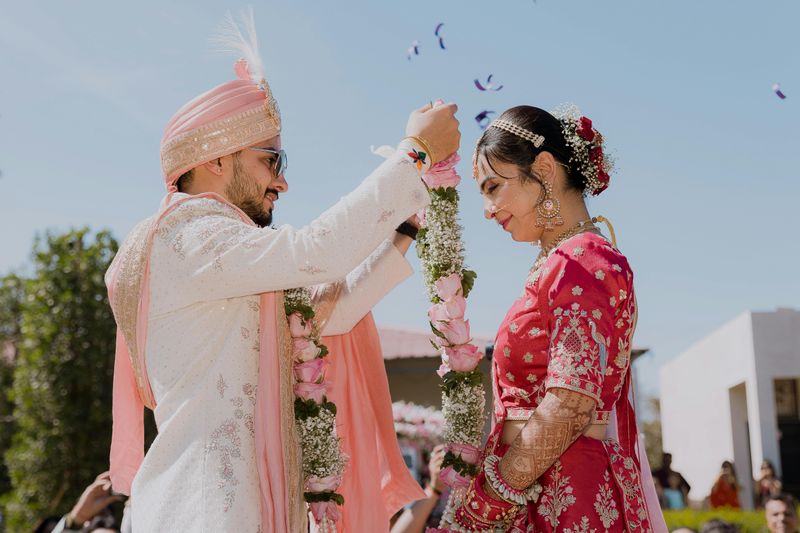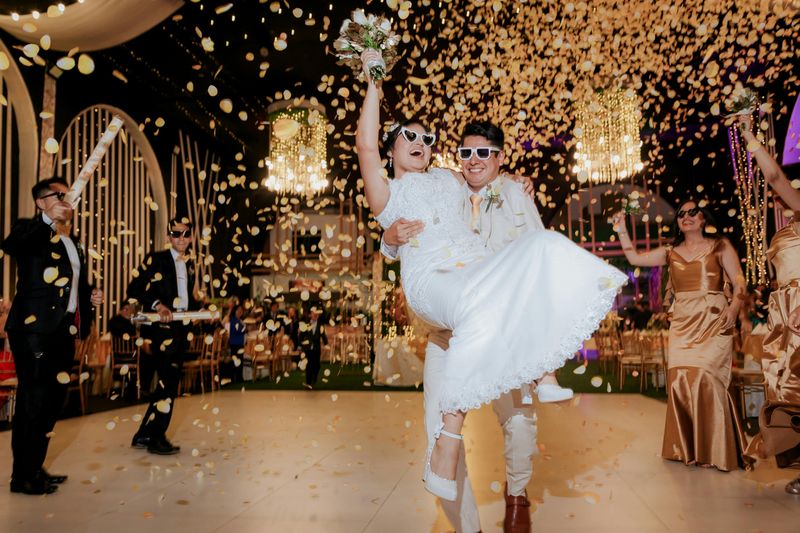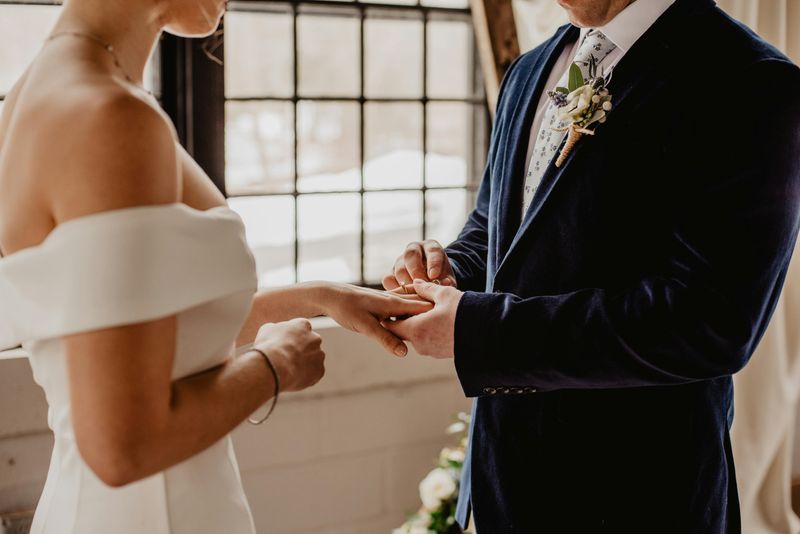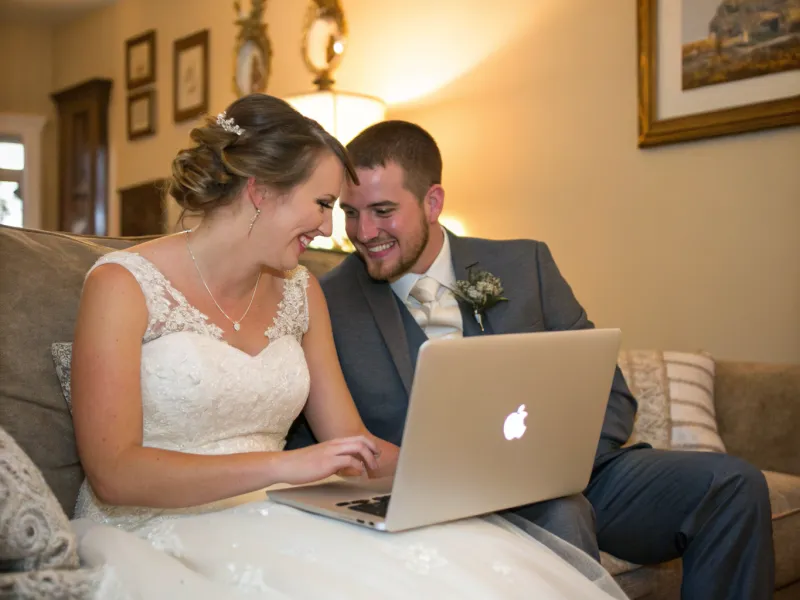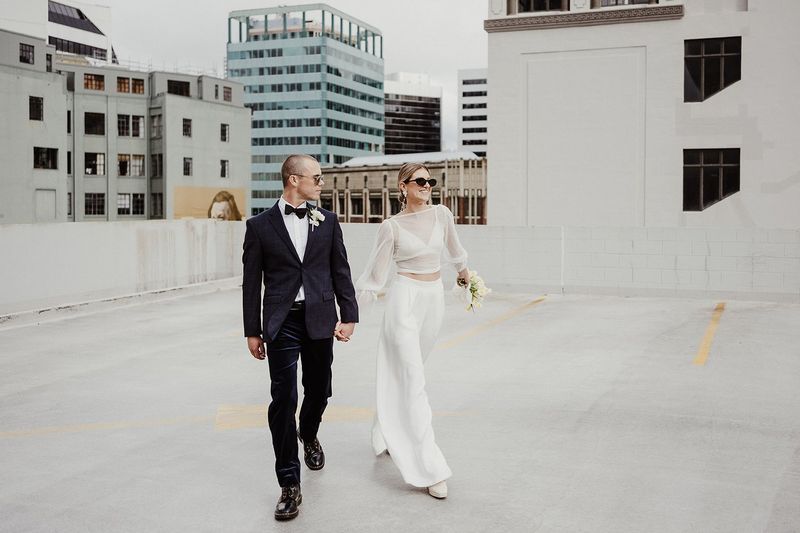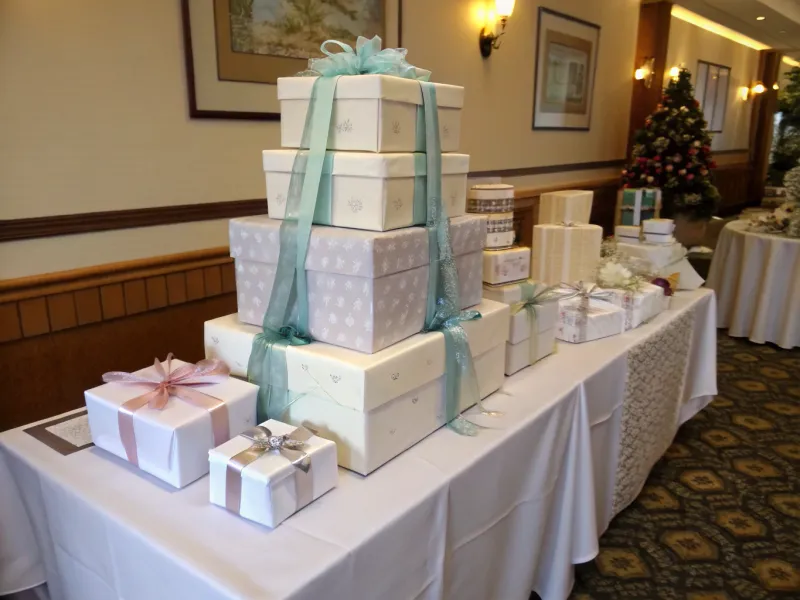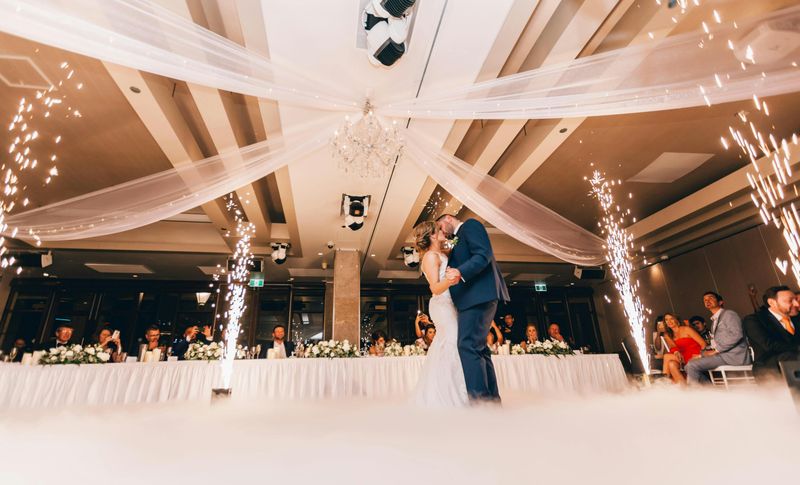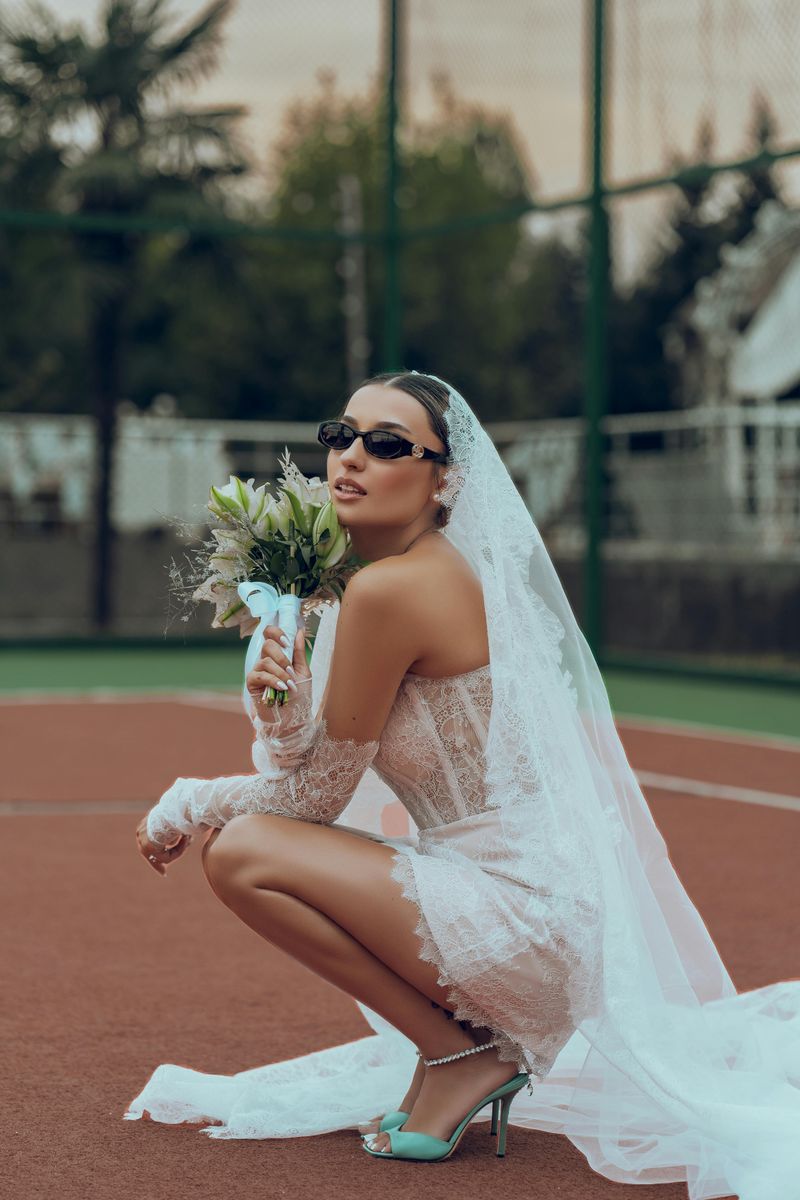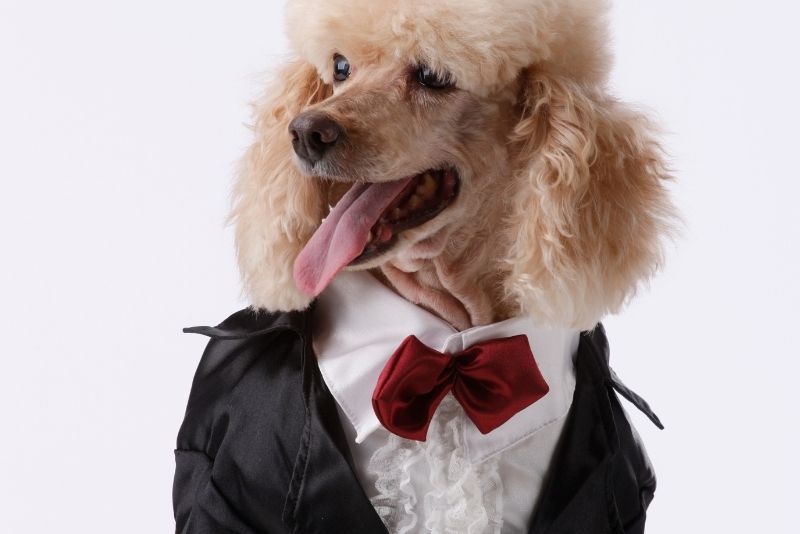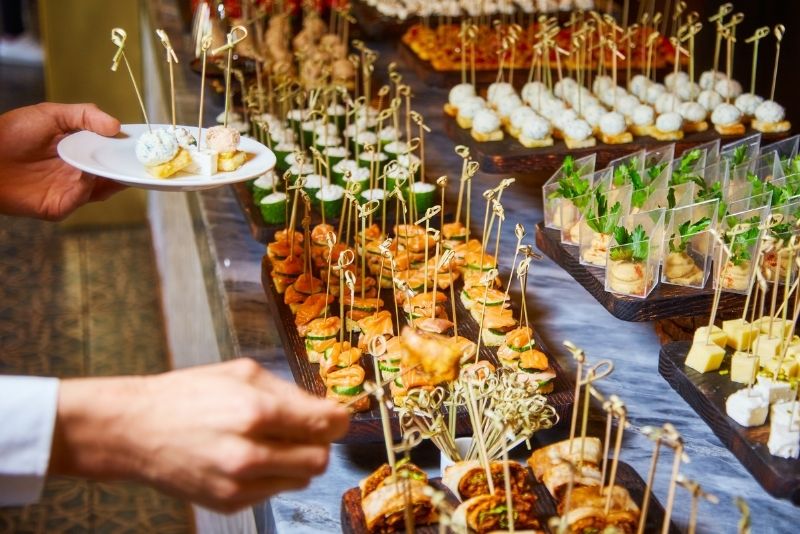Ah, the 1970s—a time when weddings were all about grandeur, tradition, and those unforgettable puffy sleeves. Fast forward to today, and you’ll find that weddings have taken on a whole new vibe.
It’s like flipping through a retro photo album and realizing just how much has changed since your parents or even grandparents tied the knot. Over the decades, wedding traditions have evolved dramatically, reflecting shifts in society, culture, and personal preferences.
Whether it’s the influence of social media or the rise of destination weddings, these changes have transformed how couples celebrate their special day. Let’s explore 28 unique ways that American weddings have morphed since the ’70s, bringing nostalgia, surprise, and a touch of humor along the way.
1. De la iglesia a la playa
Los años setenta fueron sinónimo de bodas por la iglesia, en las que las parejas intercambiaban votos bajo la atenta mirada de familiares, amigos y tradiciones religiosas. Estas ceremonias reflejaban a menudo una profunda conexión con la fe y la comunidad, y se celebraban en grandes catedrales o pintorescas iglesias parroquiales. Hoy en día, la playa se ha convertido en una alternativa muy popular.
Las parejas optan ahora por el sereno telón de fondo del océano, con el sonido de las olas como banda sonora natural de sus votos. Este cambio de la iglesia a la playa no es sólo una cuestión de ubicación; es un reflejo del cambio de valores y del deseo de una celebración más personalizada y menos formal.
2. La revolución del vestido
In the 1970s, wedding dresses were all about extravagance—think puffy sleeves, high necklines, and lots of lace. These gowns were designed to impress, often featuring elaborate trains and intricate detailing. They were a statement of elegance, reflecting the era’s fashion trends and societal expectations.
Hoy en día, el panorama de la moda nupcial ha cambiado significativamente. Las novias modernas adoptan una amplia gama de estilos, desde diseños minimalistas hasta looks atrevidos y poco convencionales. El énfasis se pone en la individualidad, y los vestidos suelen hacerse a medida para reflejar la personalidad y los gustos únicos de la novia.
3. El auge de las bodas en destino
En los años setenta, las bodas solían ser locales, y la mayoría de las parejas optaban por casarse en su ciudad natal rodeados de caras conocidas. La idea de una boda en un destino era casi inaudita, reservada a los ricos o a unos pocos aventureros.
Hoy en día, las bodas en un destino se han convertido en una tendencia popular que ofrece a las parejas la oportunidad de combinar sus nupcias con una escapada exótica. Este cambio refleja un deseo más amplio de experiencias únicas y memorables, que permite a las parejas celebrar su amor en lugares impresionantes de todo el mundo. Desde playas tropicales a castillos históricos, las bodas en destino ofrecen infinitas posibilidades de personalización y aventura.
Esta tendencia también pone de manifiesto un cambio en las prioridades, ya que las parejas valoran cada vez más las experiencias por encima de las posesiones materiales. El atractivo de una boda en un destino reside en su capacidad para crear recuerdos duraderos, brindando la oportunidad de escapar de lo ordinario y embarcarse en un nuevo viaje juntos. Tanto si se trata de una ceremonia íntima con familiares y amigos cercanos como de una gran celebración, las bodas en un destino encarnan el espíritu de aventura y romanticismo que se ha convertido en el sello distintivo de las historias de amor modernas.
4. Impacto de las redes sociales
Plataformas como Instagram, Facebook y TikTok se han convertido en parte integral de la experiencia de la boda, permitiendo a las parejas compartir cada momento en tiempo real con una audiencia global. Este cambio ha transformado las bodas en eventos sociales, en los que la presencia en línea es tan importante como la celebración física.
El auge de los hashtags, las retransmisiones en directo y los feeds personalizados ha creado una nueva dimensión de conectividad que permite a invitados y seres queridos lejanos participar virtualmente en las celebraciones. Este cambio también refleja un cambio cultural más amplio hacia la gratificación instantánea y el deseo de validación a través de "me gusta" y "compartir".
Aunque las redes sociales han mejorado la capacidad de conectar y compartir, también han introducido nuevas presiones para que las parejas creen momentos perfectos. Este doble impacto pone de relieve la naturaleza cambiante de las bodas en la era digital, donde la tecnología y la tradición se entrecruzan de forma dinámica y a veces impredecible.
5. Inflación presupuestaria
Antes, las parejas solían confiar en el apoyo familiar, los salones comunales y los toques caseros para dar vida a su día especial. Hoy en día, los presupuestos de las bodas se han disparado, y el coste medio de una boda alcanza cifras astronómicas en algunas zonas.
Esta inflación se debe a una combinación de factores, como el deseo de celebraciones personalizadas y elaboradas, la influencia de las redes sociales y el auge del propio sector de las bodas. Las parejas modernas invierten en todo tipo de servicios, desde locales de lujo a organizadores profesionales, trajes a medida y catering gourmet.
Esta tendencia refleja un cambio más amplio hacia el consumismo y el deseo de crear un evento verdaderamente inolvidable. Sin embargo, también pone de manifiesto las presiones a las que se enfrentan las parejas para satisfacer estas elevadas expectativas, que a menudo desembocan en tensiones económicas y estrés. Aunque las bodas se han vuelto más extravagantes y personalizadas, la esencia de celebrar el amor y el compromiso no ha cambiado.
6. Evolución de los roles de género
La década de 1970 fue una época en la que los roles tradicionales de género ocupaban un lugar destacado en las bodas, con novias y novios que cumplían unas expectativas y responsabilidades específicas. Las novias solían ser el centro de atención de la boda, mientras que los novios desempeñaban un papel secundario.
Las parejas modernas apuestan por la igualdad y la colaboración, y ambos participan activamente en la planificación y la toma de decisiones. Este cambio refleja cambios sociales más amplios, ya que las normas tradicionales de género se cuestionan y redefinen. Los papeles en la boda son ahora más fluidos, y las parejas eligen compartir o intercambiar responsabilidades en función de sus puntos fuertes y preferencias.
El cambio en los roles de género se extiende también a las propias ceremonias nupciales, con más parejas que optan por votos no tradicionales y rituales inclusivos. Esta transformación es un testimonio de los avances hacia la igualdad de género y del deseo de crear una experiencia nupcial más equilibrada y auténtica.
7. La personalización por encima de la tradición
En los años setenta, las bodas seguían en gran medida un formato estructurado y se ceñían a las costumbres culturales y las expectativas convencionales. Hoy en día, la individualidad ocupa un lugar central, y las parejas diseñan celebraciones que reflejan sus personalidades, valores e historias de amor únicas. Cada detalle -desde el lugar de celebración y la decoración hasta la música y el menú- es una expresión de quiénes son, alejándose de las rígidas tradiciones para ofrecer una experiencia más personalizada.
Este cambio coincide con una mayor aceptación cultural de la autenticidad y la expresión personal. En lugar de ajustarse a un guión estándar, las bodas modernas destacan lo que hace distinta a cada pareja. Las relaciones actuales celebran tanto la individualidad como la asociación, lo que da lugar a ceremonias profundamente significativas y genuinamente representativas de quienes intercambian votos.
8. Recepciones informales e íntimas
Grand, formal receptions once defined wedding celebrations, with banquet halls, multi-course meals, and carefully orchestrated entertainment setting the tone. In contrast, many modern couples now favor intimate, relaxed gatherings that foster genuine connection. Whether through backyard celebrations, family-style dining, or food trucks, receptions today often focus on simplicity and warmth rather than extravagance.
Esta preferencia en evolución da prioridad a las interacciones significativas frente a las exhibiciones elaboradas. Un ambiente relajado anima a los invitados a mezclarse libremente, creando una experiencia más personal. Las bodas reflejan cada vez más el estilo de vida y los valores de la pareja, pasando de ser eventos basados en la tradición a celebraciones que dan prioridad a la comodidad, la autenticidad y la conexión emocional.
9. Bodas tecnológicas
Hace décadas, la tecnología para bodas consistía en poco más que cámaras de cine que captaban los momentos clave. La era digital ha transformado estas celebraciones, integrando desde drones y experiencias de realidad virtual hasta retransmisiones en directo y aplicaciones para bodas. La tecnología desempeña ahora un papel crucial a la hora de mejorar el compromiso, documentar los recuerdos y agilizar la planificación.
Las redes sociales y las herramientas digitales han transformado la forma en que las parejas organizan su día especial, ofreciendo oportunidades ilimitadas de personalización. Aunque la innovación introduce posibilidades apasionantes, el reto consiste en mantener un equilibrio: utilizar la tecnología para realzar la esencia de la ocasión, en lugar de eclipsarla. Las bodas de hoy en día fusionan la tradición con la comodidad moderna, creando experiencias envolventes e inolvidables.
10. Bodas temáticas
Antes, las bodas tradicionales seguían un formato familiar con poco margen para la divergencia creativa. Ahora, las celebraciones temáticas permiten a las parejas tejer sus pasiones, intereses y personalidades en cada elemento de su gran día. Ya se inspiren en una época vintage, una estética rústica o un escenario de fantasía, estas bodas ofrecen oportunidades ilimitadas para la expresión imaginativa.
Más allá del atractivo estético, los temas crean experiencias envolventes tanto para las parejas como para los invitados. Los detalles cuidadosamente seleccionados -decoración, atuendo y entretenimiento coordinados- dan vida a la visión única de una boda. Esta tendencia creciente refleja un cambio cultural hacia la personalización, donde la tradición y la creatividad se combinan para crear eventos únicos.
11. Celebraciones respetuosas con el medio ambiente
En el pasado, la sostenibilidad no era una preocupación primordial en las bodas, en las que la decoración fastuosa y las prácticas derrochadoras eran la norma. Hoy en día, la conciencia medioambiental desempeña un papel importante en la organización de bodas. Las parejas buscan cada vez más alternativas sostenibles, desde invitaciones recicladas y decoración biodegradable hasta cocina local y moda ecológica.
Este enfoque consciente refleja una mayor conciencia social de la responsabilidad medioambiental. El deseo de minimizar los residuos y reducir la huella de carbono influye en muchas decisiones de las bodas modernas. Al incorporar opciones sostenibles, las parejas honran no solo su amor mutuo, sino también su compromiso con el planeta, demostrando que la elegancia y la conciencia ecológica pueden coexistir maravillosamente.
12. Votos no tradicionales
Hace décadas, los votos matrimoniales solían seguir un guión estructurado y tradicional, que dejaba poco margen a la individualidad. Hoy en día, las parejas elaboran sus propias promesas, añadiendo profundidad personal a uno de los momentos más significativos de la ceremonia.
Redactar votos personalizados permite a la pareja expresar su amor y compromiso de un modo auténtico y profundamente personal. Esta tendencia coincide con un movimiento cultural más amplio hacia la apertura emocional y la individualidad en las relaciones. A medida que las parejas se alejan de las tradiciones rígidas, las ceremonias se vuelven más íntimas y reflejan la singularidad de su vínculo a través de palabras pronunciadas directamente desde el corazón.
13. Experiencias interactivas
Las recepciones del pasado eran en gran medida asuntos formales, con asientos estructurados y entretenimiento fijo. En cambio, las bodas modernas incorporan ahora elementos interactivos diseñados para atraer a los invitados y crear recuerdos duraderos. Desde puestos de cócteles y fotomatones hasta espectáculos en directo y juegos sobre el césped, las celebraciones se han convertido en experiencias dinámicas.
Las parejas de hoy en día dan prioridad a la participación, asegurándose de que los invitados se sientan contribuyentes activos en lugar de observadores pasivos. Estos toques personales no sólo aumentan el disfrute, sino que también muestran la creatividad y los intereses de la pareja. Una boda ya no es sólo una ceremonia: es un acontecimiento envolvente en el que las risas, la conexión y la celebración cobran protagonismo.
14. Decoración DIY y toques personales
La estética de las bodas de los años setenta solía seguir un planteamiento formal y estandarizado, con escaso margen para la personalización. Hoy en día, el auge de la decoración DIY ha transformado el diseño de bodas, permitiendo a las parejas infundir a sus celebraciones detalles hechos a mano que reflejan su estilo único.
Desde centros de mesa artesanales hasta rótulos personalizados, estos elementos creativos aportan calidez y autenticidad al evento. Más allá de la estética, los elementos de bricolaje a menudo proporcionan una alternativa rentable, haciendo que la personalización sea accesible a todos. Este enfoque práctico de la organización de bodas pone de relieve un cambio hacia celebraciones significativas y autoexpresivas que se sienten realmente únicas.
15. Microbodas
Las bodas, antaño caracterizadas por grandes listas de invitados y grandes espacios, son cada vez más pequeñas e íntimas. Las microbodas, normalmente con entre 20 y 50 invitados, ofrecen a las parejas la oportunidad de centrarse en vínculos significativos más que en la grandeza logística.
Con menos asistentes, las parejas pueden dar prioridad a la calidad sobre la cantidad, creando un ambiente relajado y profundamente personal. Esta tendencia refleja el cambio de actitud hacia las celebraciones matrimoniales, en las que la intimidad y la autenticidad suelen tener más valor que el espectáculo. Una lista de invitados más reducida permite disfrutar de detalles más cuidados, conversaciones más profundas y una experiencia general más intencionada y sincera.
16. Transformaciones de la fiesta nupcial
Antes, las despedidas de soltera eran uniformes, con vestidos a juego y atuendos estandarizados. Hoy prima la individualidad, y las damas de honor y los padrinos adoptan estilos, colores y roles diferentes.
Este cambio reconoce que las amistades y las relaciones son únicas, y las despedidas de soltera deben reflejar esa diversidad. Ya sea a través de vestidos desparejados, fiestas nupciales que incluyan a ambos sexos o roles personalizados, las parejas modernas celebran a las personas de su vida con un enfoque nuevo. Alejándose de las tradiciones rígidas, las despedidas de soltera representan ahora las personalidades y los vínculos que realmente importan.
17. Formatos de ceremonia innovadores
Las ceremonias de boda tradicionales solían ser predecibles, con filas de sillas frente al altar. Hoy en día, las parejas están reimaginando los diseños de las ceremonias para crear una experiencia más íntima y atractiva. Los asientos circulares, las disposiciones en espiral y los montajes envolventes rompen con lo convencional y fomentan una mayor conexión entre la pareja y sus invitados.
Esta evolución refleja un deseo más amplio de interacciones significativas. Al adoptar formatos creativos, las parejas crean ceremonias inclusivas y personales, asegurándose de que sus seres queridos no sean meros testigos, sino participantes integrales en su celebración. Las bodas siguen evolucionando, combinando tradición y sensibilidad moderna para crear momentos únicos y especiales.
18. Recepciones de camiones de comida
Las cenas formales de varios platos en salones de banquetes definían antaño los banquetes de boda. En cambio, los camiones de comida se han convertido en la opción favorita de las parejas modernas que buscan añadir un toque relajado y dinámico a su celebración. Estas cocinas móviles, que ofrecen una gran variedad de platos en un ambiente informal, crean una experiencia gastronómica vibrante e interactiva.
El atractivo de las recepciones con food trucks reside en su flexibilidad y personalización. Los invitados pueden degustar diferentes platos, disfrutar de un ambiente más social y participar en la experiencia culinaria de una forma que el catering tradicional no suele ofrecer. A medida que las bodas siguen evolucionando, la creatividad en las opciones gastronómicas refleja el creciente deseo de celebraciones únicas, memorables y personalizadas.
19. Ceremonias de fusión cultural
Antes, las bodas se ceñían estrictamente a las tradiciones culturales y las ceremonias seguían al pie de la letra las costumbres establecidas. Hoy en día, las parejas mezclan diversas influencias para crear celebraciones que honran tanto la herencia como la individualidad. Las ceremonias de fusión cultural entrelazan a la perfección las tradiciones, reflejando la riqueza multicultural de las relaciones modernas.
Al incorporar elementos significativos de diferentes culturas -ya sea a través del atuendo, los rituales o la cocina-, las parejas crean una experiencia inclusiva y profundamente personal. Este cambio pone de relieve el creciente énfasis en la unidad y el respeto por los diversos orígenes, garantizando que el amor ocupe el centro del escenario de una manera que es a la vez auténtica y representativa de las identidades compartidas.
20. Entretenimiento interactivo
El entretenimiento de una boda solía limitarse a una banda en directo o un DJ, y los invitados disfrutaban pasivamente de la música. Ahora, los elementos interactivos están redefiniendo la forma en que las parejas involucran a sus asistentes. Desde pistas de baile envolventes y actuaciones en directo hasta juegos de trivial y karaoke, el entretenimiento se ha convertido en parte integral de la experiencia.
Esta tendencia transforma las recepciones en acontecimientos dinámicos en los que los invitados participan activamente en lugar de limitarse a observar. Al incorporar entretenimiento creativo, las parejas hacen que sus celebraciones sean más memorables, garantizando que la energía se mantenga alta y el ambiente siga siendo atractivo durante toda la noche.
21. Bodas entre semana
Las ceremonias de fin de semana eran la norma, elegidas por su comodidad y tradición. Sin embargo, cada vez son más las parejas que se casan entre semana, atraídas por la mayor disponibilidad de lugares, los costes más bajos y la sensación de mayor intimidad. Este cambio permite celebraciones más personalizadas y facilita el acceso a lugares y proveedores muy solicitados.
Con un ambiente más reducido y relajado, las bodas entre semana fomentan las interacciones significativas y el tiempo de calidad con los seres queridos. Este enfoque, que da prioridad a la autenticidad sobre lo convencional, subraya un movimiento más amplio hacia las bodas que reflejan las preferencias personales en lugar de las expectativas sociales.
22. Bodas virtuales
Hace décadas, las bodas eran exclusivamente presenciales y los invitados tenían que desplazarse para asistir. Hoy, la tecnología salva esa distancia y hace posible que seres queridos de todo el mundo participen en tiempo real. Las bodas virtuales ofrecen una solución inclusiva, que garantiza que la distancia ya no impida conexiones significativas.
La transmisión en directo, los brindis virtuales y los elementos interactivos permiten a los invitados remotos compartir la alegría de la ocasión. Al incorporar elementos digitales, las parejas amplían sus celebraciones más allá de las limitaciones físicas, demostrando cómo la tecnología sigue dando forma y mejorando las experiencias de las bodas modernas.
23. Elopements
Antes consideradas poco convencionales, las escapadas se han convertido en la opción preferida de las parejas que buscan una forma privada y significativa de intercambiar votos. Se ha pasado del secretismo a la intimidad, y las parejas eligen paisajes impresionantes, destinos de aventura o sencillas ceremonias en los juzgados para celebrar su compromiso.
Despojadas de las expectativas de los eventos a gran escala, las escapadas se centran por completo en la pareja y su historia de amor. Esta tendencia creciente refleja un deseo de autenticidad, en el que la esencia del matrimonio prima sobre las celebraciones elaboradas.
24. Registros de regalos modernos
Las listas de regalos de los grandes almacenes solían ser la norma: las parejas elegían lo esencial para empezar su vida juntos. Ahora, las plataformas en línea han revolucionado el proceso de hacer regalos, ofreciendo una flexibilidad que se adapta a diversos estilos de vida.
Los registros modernos incluyen experiencias, fondos para la luna de miel, donaciones benéficas e incluso aportaciones para futuras inversiones. Esta evolución pone de relieve un cambio hacia la practicidad y la personalización, que permite a las parejas recibir regalos acordes con sus intereses y necesidades. La comodidad de las plataformas digitales también simplifica el proceso para los invitados, haciendo que las donaciones sean más intuitivas y significativas.
25. Opciones modernas de entretenimiento
El entretenimiento tradicional en las bodas giraba a menudo en torno a la música y el baile, pero las celebraciones de hoy en día ofrecen experiencias mucho más envolventes. Las parejas incorporan ahora elementos como pintores en directo, artistas aéreos, fotomatones interactivos y actuaciones sorpresa para entretener a los invitados durante toda la noche.
Estos añadidos creativos garantizan que la boda siga siendo atractiva y memorable. El objetivo es crear una atmósfera dinámica en la que todos los invitados se sientan parte de la experiencia, haciendo que la celebración sea tan emocionante como personal.
26. Elección de atuendos modernos
En otros tiempos, la moda nupcial estaba dominada por estrictos códigos de vestimenta, con novias vestidas de blanco y novios de esmoquin negro. Hoy prima la expresión personal, lo que ha dado lugar a un aumento de los atuendos nupciales no tradicionales.
From colorful gowns and jumpsuits to tailored suits in unexpected hues, modern couples embrace individuality in their fashion choices. This shift reflects a broader movement toward authenticity, where attire serves as an extension of personal style rather than a rigid expectation. By choosing outfits that align with their unique vision, couples create a wedding aesthetic that feels truly their own.
27. Pet-Inclusive Ceremonies
Back in the ’70s, pets stayed home while their humans said “I do.” But today? Fido might just be the ring bearer. Modern couples are bringing their furry (and sometimes feathered) companions into the spotlight, from walking down the aisle to starring in photo ops with flower crowns and bow ties.
Including pets isn’t just adorable—it’s meaningful. They’re family, after all. Whether it’s a dog with a job or a cat cameo in the wedding portraits, these pet-friendly touches reflect the deeply personal nature of today’s weddings. It’s less about formality and more about heart.
28. Late-Night Snack Bars
Once upon a time, the reception ended with cake and coffee—and maybe a polite wave goodbye. But now? The party doesn’t stop until the sliders, fries, or donut wall rolls out. Enter: the late-night snack bar.
Couples today know that dancing works up an appetite, and a surprise bite at midnight keeps the energy high. From taco stations to make-your-own s’mores, this trend is a delicious way to cap off the celebration with fun, comfort, and flair. It’s proof that weddings now are just as much about personality as they are about tradition.

